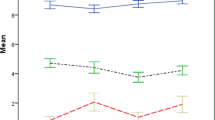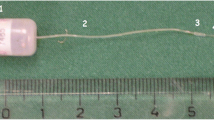Summary
Plasma and cerebrospinal fluid (CSF) concentrations of indomethacin have been determined in 52 patients hospitalized for nerve-root compression pain. Samples of blood and CSF were collected at the same time in each subject, 0.5 to 12 h after a single intramuscular injection of 50 mg indomethacin. Analgesic effect was assessed by the absolute and percentage variation in Huskisson's visual analogue scale between dosing and sampling.
According to its high lipid solubility, indomethacin rapidly crossed the blood-brain barrier, being detected in CSF 0.5 h after administration. After attainment of equilibrium within 2 h, the CSF level exceeded the free plasma level. Since the drug was extensively bound to serum albumin (99.7±0.1%), this phenomenon may represent a slight degree of binding of indomethacin in CSF.
The analgesic activity was not related to either the plasma or CSF concentration of indomethacin.
Similar content being viewed by others
References
Ferreira SH, Lorenzetti BB, Corrêa FMA (1978) Central and peripheral antialgesic action of aspirin-like drugs. Eur J Pharmacol 53: 39–48
Astier A, Renat B (1982) Sensitive high-performance liquid chromatographic determination of indomethacin in human plasma. J Chromatogr 233: 279–288
Mehta AC, Calvert RT (1983) An improved high-performance liquid chromatographic procedure for monitoring indomethacin in neonates. Ther Drug Monitor 5: 143–145
Quiding H, Häggquist SO (1983) Visual analogue scale and the analysis of analgesic action, Eur J Clin Pharmacol 24: 475–478
Bannwarth B, Netter P, Pourel J, Royer RJ, Gaucher A (1989) Clinical pharmacokinetics of nonsteroidal anti-inflammatory drugs in the cerebrospinal fluid. Biomed Pharmacother 43: 121–126
Hucker HB, Zacchei AG, Cox SV, Brodie DA, Cantwell NHR (1966) Studies on the absorption, distribution and excretion of indomethacin in various species. J Pharmacol Exp Ther 153: 237–249
Rothermich NO (1971) The fate of rectally administered radioactive indomethacin in human subjects. A preliminary report. Clin Pharmacol Ther 12: 300–301
Sheiner LB (1984) The population approach to pharmacokinetic data analysis: rationale and standard data analysis method. Drug Metab Rev 15: 153–171
Fowler PD, Dawes PT (1985) Osmosin: its effect on plasma and synovial fluid kinetics of indomethacin. Eur J Clin Pharmacol 27: 689–691
Brune K, Lanz R (1985) Pharmacokinetics of non-steroidal anti-inflammatory drugs. In: Bonta IL, Bray MA, Parnham MJ (ed) The pharmacology of inflammation. Elsevier, Amsterdam (Handbook of Inflammation, vol 5)
Helleberg L (1981) Clinical pharmacokinetics of indomethacin. Clin Pharmacokinet 6: 245–258
Alvan G, Orme M, Bertillson L, Ekstrand R, Palmer L (1975) Pharmacokinetics of indomethacin. Clin Pharmacol Ther 18: 364–373
Netter P, Lapicque F, Bannwarth B, Tamisier JN, Thomas P, Royer RJ (1985) Diffusion of intramuscular ketoprofen into the cerebrospinal fluid. Eur J Clin Pharmacol 29: 319–321
Oldendorf WK (1974) Lipid solubility and drug penetration of the blood brain barrier. Proc Soc Exp Biol Med 147: 813–816
Bonati M, Kanto J, Tognoni G (1982) Clinical pharmacokinetics of cerebrospinal fluid. Clin Pharmacokinet 7: 312–335
Zecca L, Broggini M, Pirola R, Campi R, Ferrario P, Bichisao E, Maresca V (1988) The diffusion of pirprofen into the cerebrospinal fluid in man. Eur J Clin Pharmacol 35: 81–83
Bannwarth B, Netter P, Gaucher A, Royer RJ (1986) Delayed appearance of salicylate in cerebrospinal fluid. J Rheumatol 13: 993–994
Alfredsson G, Sedvall G (1980) Protein binding of chlorpromazine in cerebrospinal fluid and serum. Int Pharmacopsychiat 15: 261–269
Day RO, Graham GG, Williams KM, Champion GD, De Jager J (1987) Clinical pharmacology of non-steroidal anti-inflammatory drugs. Pharmacol Ther 33: 383–443
Meredith TJ, Vale JA (1986) Non-narcotic analgesics. Problems of overdosage. Drugs 32 [Suppl 4]: 177–205
Huskisson EC (1974) Measurement of pain. Lancet II: 1127–1131
Yaksh TL (1982) Central and peripheral mechanisms for the antialgesic action of acetylsalicylic acid. In: Barnett HJM, Hirsh J, Fraser Mustard J (eds) Acetylslicylic acid. New uses for an old drug. Raven Press, New York
Ferreira SH (1985) Prostaglandin hyperalgesia and the control of inflammatory pain. In: Bonta IL, Bray MA, Parnham MJ (ed) The pharmacology of inflammation. Elsevier, Amsterdam (Handbook of Inflammation, vol 5)
Author information
Authors and Affiliations
Additional information
Supported by a grant from Merck-Sharp and Dohme Chibret France
Rights and permissions
About this article
Cite this article
Bannwarth, B., Netter, P., Lapicque, F. et al. Plasma and cerebrospinal fluid concentrations of indomethacin in humans. Eur J Clin Pharmacol 38, 343–346 (1990). https://doi.org/10.1007/BF00315572
Received:
Accepted:
Issue Date:
DOI: https://doi.org/10.1007/BF00315572




